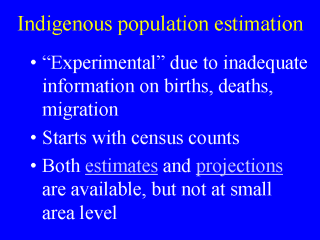|
|
|
|
front |1 |2 |3 |4 |5 |6 |7 |8 |9 |10 |11 |12 |13 |14 |15 |16 |17 |18 |19 |20 |21 |22 |23 |24 |25 |26 |27 |28 |29 |30 |31 |32 |33 |34 |review |
 |
The Australian Bureau of Statistics generates population estimates and projections for the total Australian population and for the Indigenous population. The estimates and projections for the total population are calculated using standard demographic methods which adjust for natural increase (the net change due to births and deaths) and net migration. The starting point is the count from the most recent Census, which is adjusted for the estimated under-count and for Australians who were away overseas at the time of the Census. (Overseas visitors to Australia are excluded.) The
estimates and projections for the Indigenous population cannot be done in the
same way, because the information on births, deaths and migration is not
adequate. This is because of incomplete identification of Indigenous people in
the relevant administrative data collections (this will be discussed at greater
length a little later in this lecture). As a result, a different method is used,
and the resulting estimates and projections are labelled as
"experimental". (For more information about this method, see
Cunningham J & Paradies Y, 2000, Occasional Paper: Mortality of
Aboriginal and Torres Strait Islander Australians, 1997. ABS cat. no.
3315.0, Australian Bureau of Statistics, Canberra. Available on-line at http://www.abs.gov.au/
Ausstats/ Experimental estimates and projections of the Indigenous population by age and sex are available nationally, for States and Territories, and for 36 sub-state regions (called Aboriginal and Torres Strait Islander Commission regions). However, they are not yet available at small area level. |